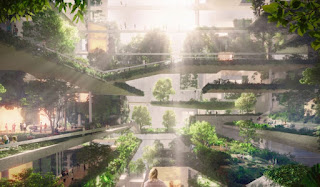Responses to Urban Context
The four readings for week three decompose four outlooks of cities and how their architecture, or lack thereof, responds to the context and fabric that exists. These texts also evaluate how to examine cities and how they respond to people's needs.
Denise Scott Brown writes the first reading, Learning from Pop. The thesis of this reading is "If high-style architects were not producing what people wanted, who is and what can we learn from them." DSB generalizes that cities can be seen as the built artifacts of a set of subcultures. She addresses that we cannot fully study human behavior and choices in architecture because many people have monetary constraints that influence their decisions. However, we can learn through the lens of pop culture, which IS a study of culture without judgment. When discussing more of the architectural process of evaluating buildings, DSB argues that form has become a topic of the past and that what is more important in design is communication across space. DSB ends the excerpt by criticizing the current conditions of design and how pop culture and popular landscape generally oppose the ideas and stances of their respective decision-makers.
Rem Koolhaas is responsible for two readings, The Culture of Congestion and Bigness. The Culture of Congestion has many themes woven throughout, and Rem examines five different built environments: Manhattan, Coney Island, elevators, The Downtown Athletic Club, and Radio City Music Hall. Manhattan serves as an example of congestion that encourages social intercourse and thus becomes a culture of congestion. Rem's fascination with Coney Island leads him to coin the term the "syndrome of the Irresistible Synthetic" where people would rather have artificial experiences than the real thing. He further states that there is a great level of emancipation through machinery, as we no longer have to design with natural systems; there are artificial replacements for everything: sunlight, climate, power, etc. The inception of elevators allows for taller buildings, and any over 5 stories becomes an accumulation of privacies. The Downtown Athletic Club serves as an example of congestion in a building, and a cluster of programs that should not belong together, but do. When buildings like this exist, they become a layer within the metropolis and reject the theory that specific functions belong in a single place. The Radio City Music Hall again demonstrates a design that exists as an artificial experience of nature. The curtain to the stage and the lighting around it was created to be the sunrise and sunset. The conclusion that Rem makes at the end is that the goal of these projects is to "establish fantasies as realities in the world" and with enough of this infrastructure we can build "a world totally fabricated by man, i.e., to live inside fantasy" through our built environment.
The second reading, Bigness, Rem begins with five points/theories against bigness that seem to be the current understanding and outlook on large buildings. The issues that people had with big buildings were that they consisted of the autonomy of its parts, that the art of architecture was useless in these buildings, that the facade
could not be revealing of the program, and that big buildings do not consider context. Rem rejects these theories and first points to the European precedent of accepting bigness. He describes Paris and how the size of buildings is not a threat to the existing infrastructure or history of place. Further, Rem supports his argument by addressing how bigness does destroy, but in its new creation, it can resemble what it breaks and gives an opportunity for better systems and innovation. In this same line of thought, Rem writes that bigness can compete with the city, and with enough quantity of programs, a big building IS a city itself. This theory can be seen as a project, The Line, is a project of a linear wall-city that contains everything a person needs within its envelope. Is this the future of architecture? Is this the best response to the climate crisis; to live in completely artificial biomes? Very utopian, but personally makes me a little uneasy.
The final reading, Made in Tokyo, was written by Atelier Bow-wow. The studio evaluates the composition of Tokyo and searches for/evaluates what they call "Da-me architecture" which are buildings without architectural aesthetic or form. Da-me architecture is "anti-historic, anti-planning, anti-classification" and generally generic buildings. I wonder if vernacular could be a substitute for da-me, or if Bow-wow thinks these buildings deserve their own classification. Bow-wow focuses on buildings and structures that overlap in one of 3 orders: category, structure, and use. The studio suggests that high-style architecture has all three of these orders included within their design, but Da-me has only one or two. Through the omission or need of these orders, Da-me has more freedom within itself to become what it needs to be.



Using The Line as an example of late-phase Bigness is interesting. It seems like a case study of a scenario when Koolhaas's ideas are used in modes of unchecked capitalism. Like the misapplication of Venturi/Scott-Brown's ideas in Learning From Las Vegas, Bigness has been similarly reduced to the idea that architectural concepts can be applied at any scale.
ReplyDelete